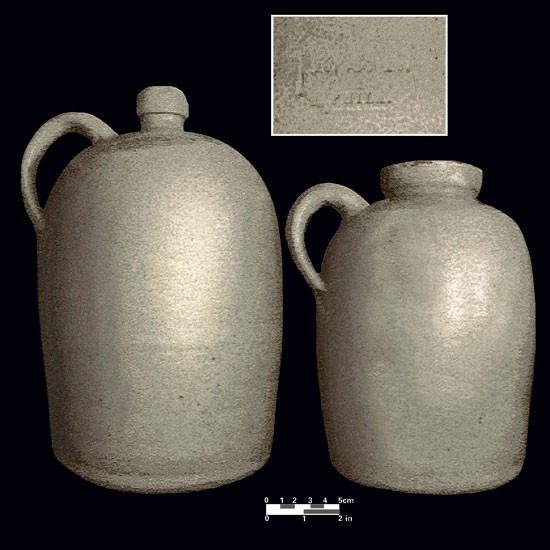
Jug and handled jar, Richard Clinton Remmey, Philadelphia, 1859–1880s. Salt-glazed stoneware. H. 11" and 9". (Private collection; photo, Michael Murphy.) The jar holds 80 liquid ounces, or 5 quarts. Its mouth, formed by a collar with a flat lip, has an interior diameter of two inches. An internal lid or ledge seat suggests a formal lid, either ceramic or cork, was sealed to it with wax or tied to the collar.
The two gray-bodied, salt-glazed stoneware vessels shown here (fig. 1) were purchased as a lot in an auction in southern New Jersey. The vessel on the left is stamped “RCR” (Richard Clinton Remmey) above “PHILA” (Philadelphia) within a clipped rectangle. This company produced stoneware from 1859 through the 1880s.[1] Although the second vessel is unmarked, it is believed to have been made by the same factory, possibly at the same time. Both vessels exhibit very similar handle attachments, body color, form, and glaze.
The vessel on the left is a standard, wheel-thrown, undecorated two-gallon jug. The one on the right is, for lack of a better term, a handled jar, undecorated and unmarked, with a semi-wide mouth. Unglazed patches along the shoulder represent points of contact with a jug saggar or stacker. Unglazed patches on the body below the shoulder represent points of contact from informal wads. The glaze around these points of contact exhibit a distinctive greenish yellow hue.
So what is this vessel? Is it a jar, a jug, or a crock? This vessel is unlikely to be a preserve jar since the diameter of the mouth is slightly smaller than contemporary glass canning jars, making removal of solid food stores difficult. In her book on American stoneware, Georgeanna Greer pictures a similar vessel, a handled, small-mouthed preserve jar with a wider mouth, more typical of contemporary glass canning jars.[2] Its plain, undecorated appearance suggests a utilitarian, storage-type function, possibly industrial (chemical storage).
William B. Liebeknecht
Principal Archaeologist
Hunter Research, Inc.
wbl@hunterresearch.com
http://hunterresearch.com
William C. Ketchum Jr., American Stoneware (New York: Henry Holt and Company, 1991), p. 87.
Georgeanna Greer, American Stonewares: The Art and Craft of Utilitarian Potters, 3rd ed., rev. (Atglen, Pa.: Schiffer Publishing, 1999), p. 87.
